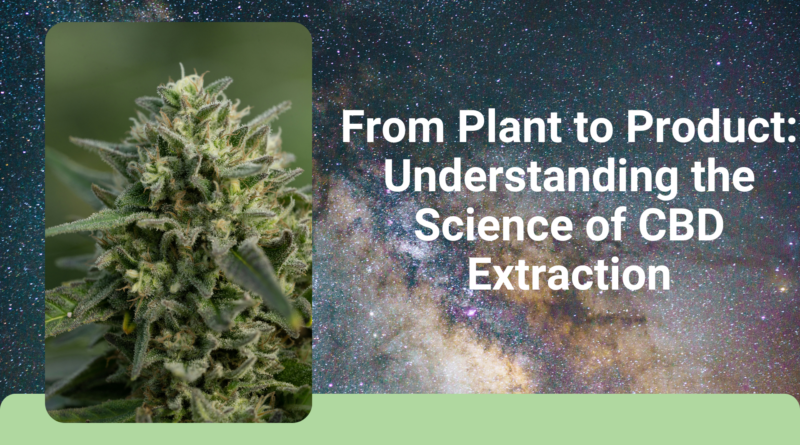From Plant to Product: Understanding the Science of CBD Extraction
CBD, short for cannabidiol, is one of the cannabinoids found in the hemp plant. It’s well known for its potential health benefits, including pain relief, reduced anxiety, and improved sleep. CBD extraction is a critical process that transforms the hemp plant into a plethora of potent and pure products.
Understanding the science of CBD extraction offers insight into the purity, potency, and quality of the final product, demystifying how the essence of a plant becomes a part of daily health and wellness routines.
The Basics of CBD Extraction
There are various methods used to extract CBD from hemp, each has its own benefits. One of the most popular methods is CO2 (carbon dioxide) extraction. CO2, is a natural compound that’s largely used in the food and beverage industry.
For this method, CO2 is pressurized and cooled to become a liquid, after which, it is used to extract the CBD from the plant material. This method is highly efficient and produces a pure, high-quality extract, making it a favorite among CBD manufacturers.
Another common method is solvent extraction or cryogenic extraction. In this, a solvent such as ethanol or butane is used to dissolve the CBD from the plant. The solution is then filtered to remove any impurities, leaving behind a concentrated CBD extract. Cryogenic processes use temperatures well below freezing to protect the terpenes and cannabinoids contained in hemp.
Importance of Proper Extraction Techniques
The importance of CBD extraction techniques plays a pivotal role to ensure safety, efficacy and quality of CBD products.
Purity and Potency: The extraction process directly influences the purity and potency of the final CBD product. Proper extraction methods can selectively isolate CBD and other beneficial cannabinoids, eliminating unwanted substances, pesticides, and contaminants. This precision ensures that consumers receive a product that is both effective and non-intoxicating.
Safety: Proper extraction techniques are essential for removing potential toxins and ensuring the product is safe for consumption. Techniques such as CO2 or cryogenic extraction are renowned for their ability to purify CBD oil without leaving harmful residues, ensuring the end product is free from solvents and chemicals that could pose health risks.
Preservation of Phytochemicals: High-quality extraction methods are designed to preserve the plant’s phytochemicals, including cannabinoids, terpenes, and flavonoids. These compounds are believed to work synergistically in what is known as the “entourage effect,” potentially enhancing the therapeutic properties of CBD.
Step-by-Step Process of CBD Extraction
- Planting and Farming the Hemp: The first step is to plant the top quality of seeds. The soil is prepared and tested for herbicides, and drainage lines are installed to ensure that the plants don’t become oversaturated.
- Harvesting the Hemp: Hemp is a fast-growing crop, and it can just take up to 5-6 months for the plants to mature fully.
- Extracting CBD: After the plant is harvested, the cannabinoids from the plant are extracted from the leaves through various extraction methods as mentioned.
According to the legal status in India, the raw material, which is the leaves, is obtained directly from the government and utilized to extract the cannabinoids, terpenes, and flavonoids, resulting in the full spectrum CBD extract used for many health benefits. Hemp seeds can be farmed and used for nutritional purposes.
Factors Influencing CBD Extraction
Quality of Plant Source: The caliber of hemp or cannabis used significantly shapes the resultant CBD’s potency. The environmental conditions under which the plant is grown, its genetic variety, and the methods applied during its harvest all play important roles in determining the final product’s effectiveness and cleanliness.
Extraction Conditions: In the realm of supercritical CO2 extraction, the precision in managing temperature and pressure is most important. These parameters are crucial for isolating desired compounds efficiently. Mismanaged conditions might not only hamper the extraction process but could also lead to the deterioration of vital components within the plant.
Compliance with Standards: Upholding stringent regulatory standards is non-negotiable for ensuring the extracted CBD’s safety, efficacy, and legal status. This involves strict adherence to established manufacturing protocols and ensuring the product’s packaging and composition meet the required guidelines.
Conclusion
CBD extraction is a refined multilayered process that requires carefully extracting the beneficial chemicals from the cannabis plant while reducing contaminants. Whether using CO2 extraction, lipid or solvent extraction, the goal remains the same: to create a pure, effective CBD extract that can be used in a range of products.
REFERENCES
- The science behind extracting CBD: From plant to potent product (2024) High Forest Releaf. Available at: https://highforestreleaf.com/the-science-behind-extracting-cbd-from-plant-to-potent-product/ (Accessed: 29 March 2024).
- CBD extraction methods: A comprehensive guide (2024) The Extract. Available at: https://www.theextract.co.uk/science/cbd-extraction-methods/ (Accessed: 29 March 2024).

